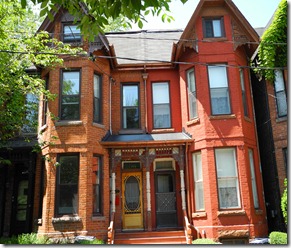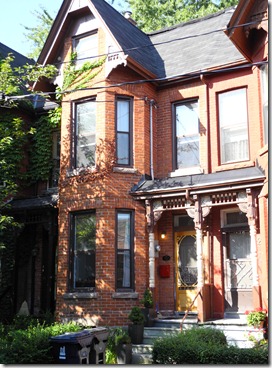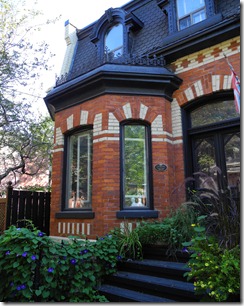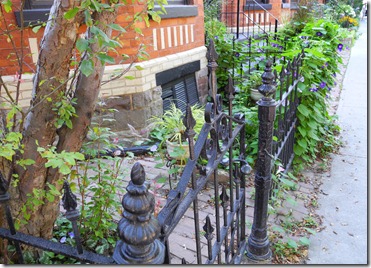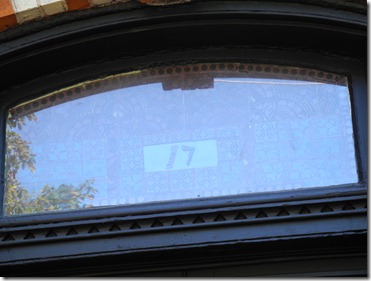Many attractive homes are located on Draper Street, which was named after William Henry Draper (1801-1877), a jurist and politician, as well as the Chief Justice of Upper Canada from 1863 to 1869. His portrait in oils hangs outside the library of Osgoode Hall. The land occupied by Draper Street, once a part of the military reserve attached to Fort York, was annexed to the city in the 1830s. It appears on the city’s maps in the year 1857, though the exact year it was cut through the woods is unknown. In the 1880s, when houses were constructed, it became a working man’s community, unlike Wellington Place at its north end.
The Bay and Gable three-story house at 22 Draper Street is particularly worth examining. It occupies the left-hand side of the two semi-detached homes seen in the photo on the left. The house is one of the seven dwellings constructed in 1890 on the site of Benton’s Lumber Yard, and is an excellent example of Toronto’s unique “Bay and Gable” houses. Number 22 Draper Street was the home and workplace of Miss Annie Riorden, a dressmaker. In this decade, the selection of ready-made dresses available at the dry goods stores was quite limited. Most women purchased material from a bolt of cloth and made their own dresses, as well as those for other members of their families. Ladies who could afford the price employed dressmakers. They chose the material and style, had a fitting, and then had the cutting and sewing done by the dressmaker. Miss Riorden chose an excellent location for her business. The matrons of the mansions on Wellington Place were frequent customers, and the proximity of her home to these residences was a great advantage.
This three-storey narrow house has large bay windows on the first floor that continue to the second-floor level. High in the pediment, the wood trim has simple designs. The original porch-supports remain today, and at the top contain sunburst patterns in the corners, with a row of spindle ornaments produced on a lathe in a lumberyard. The slate roof has not survived.
There is a transom window above the door, as well as a large window in the door itself, allowing copious daylight to enter the hallway within. It was an era before electricity, and without such designs the interior of the house would be very dim, especially during the winter months.
The tall windows were an asset for Miss Riorden as she performed the detailed tasks required to complete the cutting and sewing of a dress. With a little imagination we can picture her seated beside a large bay window on the second floor, sewing in the morning light. On winter days, perhaps she also had a small work area at the rear of the home to take advantage of the afternoon sun.
22 Draper Street on a sunny morning in June
Another home that is particularly interesting is 17 Draper St. In 1881, it was purchased from the builder by J. J. Dyas, an advertising agent, who in that year was 23 years old. When the house was restored in the twentieth century, coloured glass from a church, which had been demolished, was placed in the windows of the door. The clear glass in the transom window (above the door) is original, with more church glass placed behind it. When viewed from the narrow hallway inside, the coloured glass is very attractive. At the top of the windows in the door are wooden, half-sunburst patterns. The wood trim on the second floor gables is not original, but is a faithful copy. The front doors were purchased at an auction, and are authentic to the era when the dwelling was constructed.
Above the first floor gable, on the edge of the roof, is the original decorative wrought-iron trim, and the same material was employed for the attractive fence surrounding the front of the house. However, the fence was purchased in Dashwood, Ontario (London- Stratford area). Cast in the 1880s, it came from a grave in a churchyard. It is worth examining the unusual latch on the gate.
The door opens to a hallway where there are ornate decorations in the wood trim. The parlour is to the left of the hallway. The floors are pine, but in the hallway the original flooring has been replaced with old oak. At the rear is a large kitchen, which possesses a rolled tin ceiling. The ceiling was not in the house when it was constructed, but is typical of ceiling coverings that were in homes and shops in this era.
17 Draper St, with its Mansard roof and attractive brickwork
Wrought-iron fence around 17 Draper St. that was purchased in Dashwood Ontario.
Transom window above door of 17 Draper Street.
I have spent much of my adult life researching and photographing Toronto. I love the city and enjoy exploring it through my writing. One of the books, “The Villages Within”, was nominated for the Toronto Heritage Awards. If interested in novels with a Toronto setting, descriptions of the books are available by following the link: https://tayloronhistory.com/2012/03/22/toronto-author-publishes-seventh-novel/
They can be purchased in soft cover or electronic editions. All books are available at Chapters/Indigo and on Amazon.com. The electronic editions are less that $4 on Kobo and Kindle. Follow the links:
There Never Was a Better Time: http://bookstore.iuniverse.com/Products/SKU-000056586/THERE-NEVER-WAS-A-BETTER-TIME.aspx
Arse Over Teakettle: http://bookstore.iuniverse.com/Products/SKU-000132634/Arse-Over-Teakettle.aspx
The Reluctant Virgin; http://bookstore.iuniverse.com/Products/SKU-000188306/The-Reluctant-Virgin.aspx
The Villages Within: http://bookstore.iuniverse.com/Products/SKU-000175211/The-Villages-Within.aspx
Author’s Home Page: https://tayloronhistory.com/
Authors can be contacted at: [email protected]
